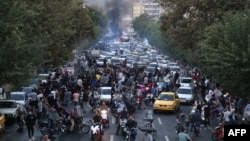Welcome back to The Farda Briefing, an RFE/RL newsletter that tracks the key issues in Iran and explains why they matter.
I'm RFE/RL correspondent Golnaz Esfandiari. Here's what I’ve been following during the past week and what I’m watching for in the days ahead.
The Big Issue
“Woman, life, freedom.” “Death to the dictator.” These are some of the chants of Iranian protesters, men and women, who have taken to the streets of dozens of cities across Iran in the past 12 days despite a crackdown by security forces, stern warnings by officials, and severe Internet cuts.
The protests were sparked by the death of 22-year-old Mahsa Amini after her arrest by Tehran’s morality police, which has galvanized Iranians in an unprecedented way while also highlighting four decades of state violence and discrimination against women who have been pushing back against state repression for years.
The government has recently arrested more than 1,200 protesters as well as 20 journalists, four lawyers, and about 25 activists and students. According to official figures, more than 40 people have been killed, including several members of security forces, while rights groups believe the real number of those killed is much higher.
Why It Matters: The protests have been going on despite a violent crackdown during which security forces used water cannons and tear gas while also firing birdshot and live rounds at protesters, according to rights groups. Amateur videos posted online also show the riot police brutally beating protesters, including women who have played a prominent role in the demonstrations. Many of the protesters appear to feel that they have nothing to lose.
An increasing number of Iranians have had enough of life under a repressive regime, a deteriorating economy crushed by U.S. sanctions, and a lack of freedom.
What’s Next: Even if the clerical establishment manages to end the protests through the use of force and intimidation, which is likely, the fury and the many grievances of Iranians, including women who have been burning their compulsory hijabs, will not go away. The bloody crackdown is likely to make Iranians even more furious with the clerical establishment.
In 2009, hundreds of thousand of Iranians held a silent protest against a disputed presidential vote. The government cracked down on the protests, killing over 70 people while arresting at least 5,000. In recent years, protests in the Islamic republic have grown more violent while protesters have moved from the 2009 chants of “Where is my vote?” and demands for reforms to calls for an end to the Islamic republic and for the clerics ruling Iran “to get lost.”
Stories You Might Have Missed
• Iranian soccer star Ali Karimi has angered authorities in the country over his support for the protests following the death of Mahsa Amini in the custody of Tehran's morality police. Calls have been made for the arrest of the highly popular Karimi, who lives in the United Arab Emirates, while others have said his properties should be confiscated.
Karimi is among a number of well-known public figures who have in recent days shown solidarity with the protesters while condemning state violence.
• Iranian Foreign Minister Hossein Amir-Abdollahian has said that Tehran has received a new signal from the United States that the "will and goodwill" exist in Washington to reach an agreement to revive the 2015 nuclear deal. The official IRNA news agency quoted Amir-Abdollahian on September 25 as saying he responded by urging the U.S. side to demonstrate "realism" so the sides could finalize a deal.
U.S. officials have not confirmed any exchange of messages. Meanwhile, the head of the International Atomic Energy Agency (IAEA) said he met with the head of Iran’s Atomic Energy Organization in Vienna for talks about an ongoing investigation into traces of uranium particles found at three undeclared sites in Iran.
What We're Watching
Ties between Iran and Ukraine have deteriorated over Iran’s sale of drones to Russia for use in its unprovoked war on its neighbor. Ukraine announced over the weekend that it was reducing diplomatic ties with the Islamic republic and withdrawing the accreditation of the Iranian ambassador over Tehran's decision to supply Russian forces with drones, a move Ukrainian President Volodymyr Zelenskiy called "a collaboration with evil.”
Iran reacted by announcing that it will give “an appropriate” response to Ukraine’s decision while also saying that the decision was "based on unconfirmed reports and resulted from media hype by foreign parties.”
Why It Matters: Tehran has in the past dismissed accusations by the United States and Ukraine that it has supplied Russia with drones. But the Ukrainian Air Force has in recent days said that it has shot down and identified Shahed-136 kamikaze drones and Mohajer-6 drones that carry munitions and can also be used for reconnaissance. The ties between the two countries could deteriorate further should Tehran continue to provide Russia with drones.
That’s all from me for now. Don’t forget to send me any questions, comments, or tips that you have.
Until next time,
Golnaz Esfandiari
If you enjoyed this briefing and don't want to miss the next edition, subscribe here. It will be sent to your inbox every Wednesday.






